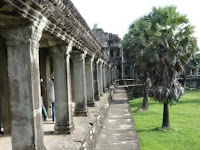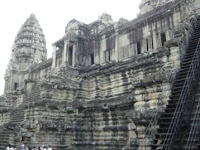
Angkor Archaeological Park, located in northern Cambodia, is one of the most important archaeological sites in South-East Asia. Stretching over some 400 km2, including forested area, Angkor contains the magnificent remains of several capitals of the Khmer Empire, from the 9th to the 15th century CE. These include the famous Temple of Angkor Wat, Angkor Thom and the Bayon Temple with its countless sculptural decorations.
Angkor was declared a UNESCO World Heritage site in 1992 - the same year it was also placed on the List of World Heritage in Danger. UNESCO has now set up a wide-ranging programme to safeguard this symbolic site and its surroundings.
Angkor Wat is the largest monument in Angkor Archaeological Park. Stretching over some 400km2, including forested area, Angkor Archaeological Park contains the magnificent remains of the different capitals of the Khmer Empire (from 9th to the 13th century). They include the famous Temple of Angkor Wat, Angkor Thom, the Bayon Temple and countless other ancient ruins of the Angkorian-era. UNESCO has set up a wide-ranging programme to safeguard this symbolic site and its surroundings.
Angkor Wat is the most famous temple in Cambodia and the soul of Khmer people - its three towers appear on Cambodia’s national flag and it is the country's prime attraction for visitors. The temple is located just 7km from Siem Reap town to the north and only 5km from the Siem Reap International Airport.
Angkor is a Sanskrit word for ‘Holy City’ while Wat in Khmer means ‘Temple’. Thus Angkor Wat literally means ‘Holy City of Temple'. Many believed that Angkor Wat temple was built between 1112 and 1152 to honour the Hindu God Vishnu who was considered to be the Supreme God of Hinduism. 
Various views of Angkor Wat Temple
Inner side of Angkor Wat
God Vishnu, Supreme God of Hinduism






Apsara BasRelief




















No comments:
Post a Comment